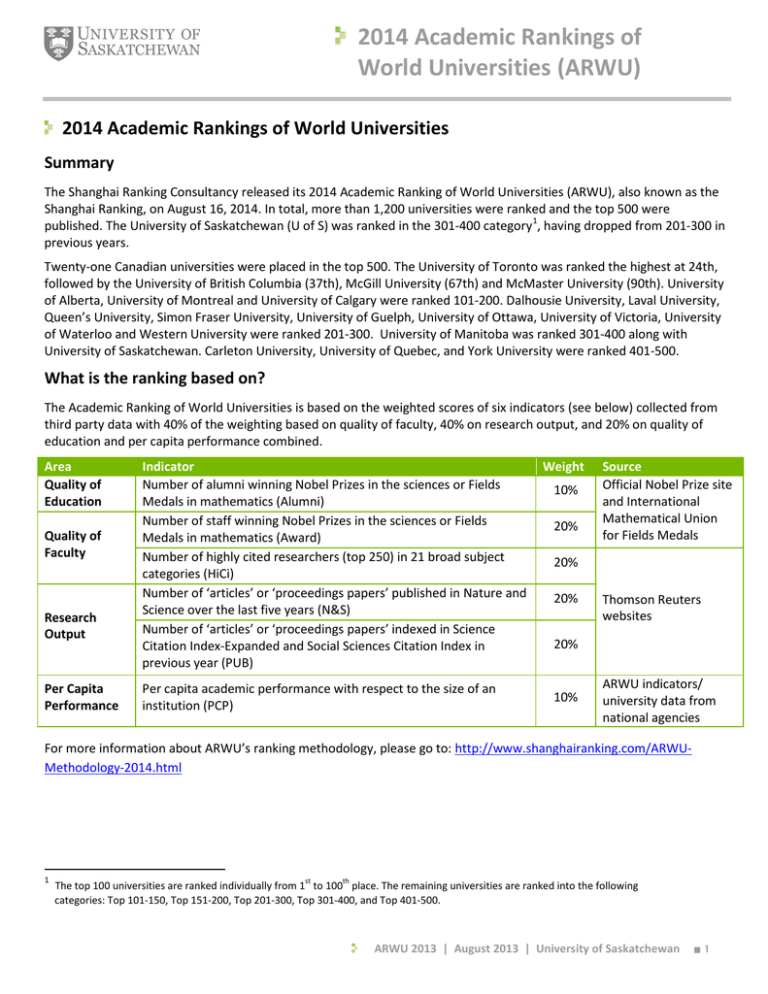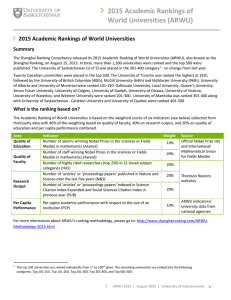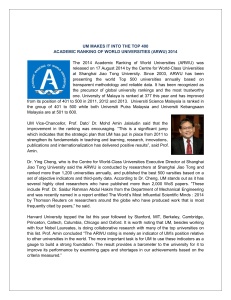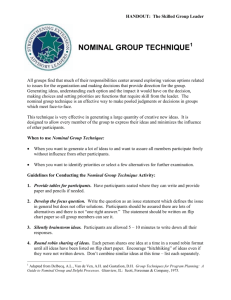2014 Academic Rankings of World Universities (ARWU)
advertisement

2014 Academic Rankings of World Universities (ARWU) 2014 Academic Rankings of World Universities Summary The Shanghai Ranking Consultancy released its 2014 Academic Ranking of World Universities (ARWU), also known as the Shanghai Ranking, on August 16, 2014. In total, more than 1,200 universities were ranked and the top 500 were published. The University of Saskatchewan (U of S) was ranked in the 301-400 category 1, having dropped from 201-300 in previous years. Twenty-one Canadian universities were placed in the top 500. The University of Toronto was ranked the highest at 24th, followed by the University of British Columbia (37th), McGill University (67th) and McMaster University (90th). University of Alberta, University of Montreal and University of Calgary were ranked 101-200. Dalhousie University, Laval University, Queen’s University, Simon Fraser University, University of Guelph, University of Ottawa, University of Victoria, University of Waterloo and Western University were ranked 201-300. University of Manitoba was ranked 301-400 along with University of Saskatchewan. Carleton University, University of Quebec, and York University were ranked 401-500. What is the ranking based on? The Academic Ranking of World Universities is based on the weighted scores of six indicators (see below) collected from third party data with 40% of the weighting based on quality of faculty, 40% on research output, and 20% on quality of education and per capita performance combined. Area Quality of Education Quality of Faculty Research Output Per Capita Performance Indicator Number of alumni winning Nobel Prizes in the sciences or Fields Medals in mathematics (Alumni) Number of staff winning Nobel Prizes in the sciences or Fields Medals in mathematics (Award) Number of highly cited researchers (top 250) in 21 broad subject categories (HiCi) Number of ‘articles’ or ‘proceedings papers’ published in Nature and Science over the last five years (N&S) Number of ‘articles’ or ‘proceedings papers’ indexed in Science Citation Index-Expanded and Social Sciences Citation Index in previous year (PUB) Per capita academic performance with respect to the size of an institution (PCP) Weight 10% 20% Source Official Nobel Prize site and International Mathematical Union for Fields Medals 20% 20% Thomson Reuters websites 20% 10% ARWU indicators/ university data from national agencies For more information about ARWU’s ranking methodology, please go to: http://www.shanghairanking.com/ARWUMethodology-2014.html 1 st th The top 100 universities are ranked individually from 1 to 100 place. The remaining universities are ranked into the following categories: Top 101-150, Top 151-200, Top 201-300, Top 301-400, and Top 401-500. ARWU 2013 | August 2013 | University of Saskatchewan 1 2014 Academic Rankings of World Universities (ARWU) Scores of the University of Saskatchewan The following table illustrates the scores for the U of S on each of the six indicators that make up the Academic Ranking of World Universities. U of S score Median score for Canadian universities U of S rank among Canadian universities3 1 2 3 4 Alumni 9.11 0 7th Award 0 0 4th4 HiCi 7.9 13.8 18th N&S 7.7 12.9 20th PUB 32.7 36.9 17th PCP 15.5 18.8 19th OVERALL 12.12 14.1 17th Indicator scores are calculated by dividing the actual indicator value by the top university value for that indicator and multiplying by 100. The U of S score of 15.5 on PCP does not mean that faculty at the university have on average 15.5 publications, rather it means the success of our university on PCP is 15.5% of the top university for this indicator. ARWU does not publish scores for institutions that are ranked lower than the top 100. This score was determined based on a calculation using the scores and weights for the six individual indicators. Twenty-one Canadian Universities were in the top 500. U of S tied with 17 institutions at 0. Only three universities scored higher than 0 in this category. The single most important factor for the drop in the ranking of the U of S was significantly lower score in the HiCi category which was based on the number of highly cited researchers (15.7 in 2013 and 7.9 in 2014). The number of Highly Cited Researchers was selected by Thomson Reuters. The previous list of highly cited researchers was issued in 2001, and it identified more than 6,000 researchers. This list of Highly Cited Researcher was used in ARWU from 2003 to 2013. In 2014, Thomson Reuters developed a new list of Highly Cited Researchers with some 3,000 names based on a different methodology. In order to have a relatively smooth transition to the new list of Highly Cited Researchers and avoid too much fluctuation of ranking results due to the methodological change, both the old Highly Cited Researchers list and the new Highly Cited Researchers list were used in the calculation of HiCi indicator in ARWU 2014, and they were equally weighted. The U of S had four highly cited researchers on the previous list, but none on the new list. Chronological Performance of the University of Saskatchewan from 2003 to 2014 The following chart illustrates the placement of the University of Saskatchewan in the Academic Ranking of World Universities since its inception in 2003. 2003 0 R a n k i n g 2004 2005 2006 2007 Year 2008 2009 2010 2011 2012 2013 2014 100 200 300 400 500 ARWU 2014 | August 2014 | University of Saskatchewan 2 2014 Academic Rankings of World Universities (ARWU) Rankings by broad subject field In addition to the overall ranking, the Shanghai Ranking Consultancy also published the top 200 universities in five broad subject fields: Natural Sciences and Mathematics (SCI), Engineering/Technology and Computer Sciences (ENG), Life and Agriculture Sciences (LIFE), Clinical Medicine and Pharmacy (MED), and Social Sciences (SOC). These rankings are compiled based on similar methodology with the overall ranking. The U of S was not ranked in the top 200 in these subject fields in 2014. Last year, the U of S ranked 151-200 in engineering/technology and computer sciences, as well as in life and agriculture sciences. The following table illustrates the placement of Canadian universities in the broad subject field rankings in 2014. University McGill University University of British Columbia University of Toronto McMaster University University of Alberta University of Montreal University of Ottawa Queen’s University University of Calgary University of Laval Waterloo University Dalhousie University Simon Fraser University University of Guelph University of Manitoba University of Victoria University of Western Ontario York University Carleton University University of Quebec University of Saskatchewan SCI 101-150 51-75 34 151-200 151-200 101-150 - ENG 76-100 101-150 24 151-200 76-100 101-150 47 - LIFE 28 33 39 76-100 101-150 101-150 151-200 76-100 - MED 42 101-150 27 45 76-100 101-150 151-200 151-200 101-150 151-200 151-200 - SOC 51-75 28 29 48 50 76-100 151-200 101-150 151-200 151-200 101-150 101-150 101-150 - Total number of fields in the top 200 5 5 5 4 4 4 3 2 2 2 2 1 1 1 1 1 1 1 0 0 0 Rankings by subject Currently, the Shanghai Ranking Consultancy only publishes rankings in five specific subjects: mathematics, physics, chemistry, computer science, and economics/business. The U of S was not ranked in the top 200 in these subjects. For more information, visit www.usask.ca/ipa ARWU 2014 | August 2014 | University of Saskatchewan 3


